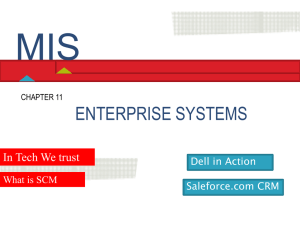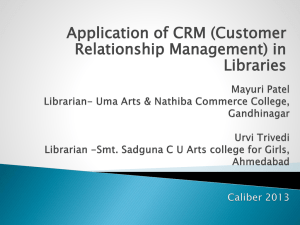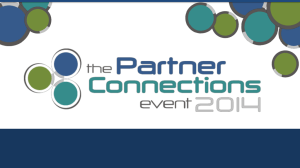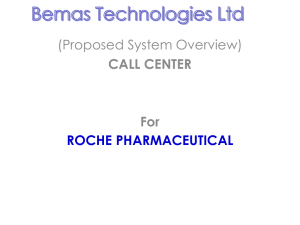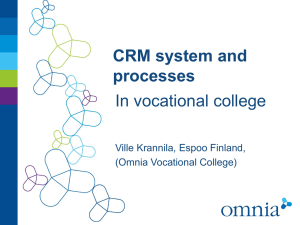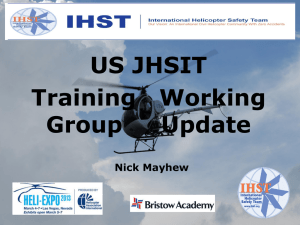Improving Supply Chains and Strengthening Customer Relationships
advertisement
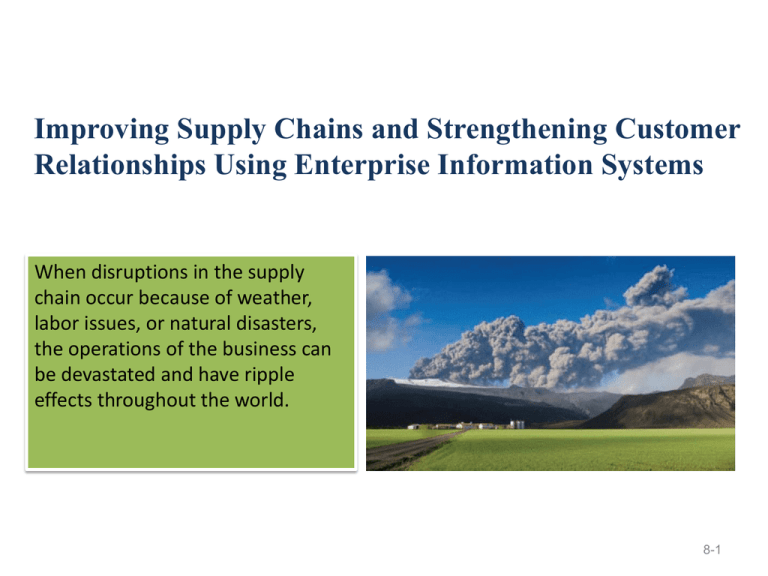
Improving Supply Chains and Strengthening Customer Relationships Using Enterprise Information Systems When disruptions in the supply chain occur because of weather, labor issues, or natural disasters, the operations of the business can be devastated and have ripple effects throughout the world. 8-1 Learning Objectives 8-2 1. Describe supply chain management systems and how they help to improve interorganizational business processes. 2. Describe customer relationship management systems and how they help to improve the activities involved in promoting and selling products to the customers as well as providing customer service and nourishing long-term relationships. Learning Objectives 8-3 1. Describe supply chain management systems and how they help to improve interorganizational business processes. 2. Describe customer relationship management systems and how they help to improve the activities involved in promoting and selling products to the customers as well as providing customer service and nourishing long-term relationships. What Is a Supply Chain? • A supply chain is a collection of companies and processes moving a product: – – – – suppliers of raw materials suppliers of intermediate components final production to the customer • Upstream—flow from sources of raw materials and components. • Downstream—flow to customers. • Suppliers have their own supply chain. • A better name: supply network. 8-4 Supply Network 8-5 Supply Chain for Apple’s iPhone 8-6 Benefits and Problems with Supply Chains • Potential benefits – Process innovations – Just-In-time Production (JIT) – Vendor-Managed Inventory (VMI) • Potential problems – Distorted information – Excessive inventories – Inaccurate capacity plans – Missed product schedules 8-7 Just-in-Time Production (JIT) • Keeping inventory is costly (storage, capital, missed production schedules). • JIT optimizes ordering quantities. – Parts and raw materials arrive when needed for production. – As orders arriver in smaller quantities, but at higher frequency) investment in storage space and inventory is minimized. • The approach was pioneered by Toyota. • It is used extensively by computer manufacturers to avoid component obsolescence (Moore’s law). – Example: Dell keeps only two hours of inventory in stock • JIT requires tight cooperation between all partners in the supply network. 8-8 Vendor-Managed Inventory (VMI) • VMI is a business model in which suppliers manage the manufacturer’s (or retailer’s) inventory levels based on preestablished service levels. • Supplier monitor’s stock levels and sales data. • VMI requires manufacturer (retailer) to share real-time data. • Benefits – – – – – Cost savings Minimized stock-out situations Accurate forecasts Reduced errors Prioritized goods shipments 8-9 The Bullwhip Effect • Ripple effects in which forecast errors and safety stocks multiply when moving up the supply chain • Happens when businesses include safety buffer to prevent stock-outs • Small end-product demand fluctuations cause large fluctuations further up the supply chain. • Small forecasting errors at end of supply chain cause large errors further up the supply chain. • Integrated business processes help mitigate the bullwhip effect. 8-10 Functions That Optimize the Supply Network • Supply Chain Management (SCM) improves the coordination of suppliers, product or service production, and distribution. 8-11 Integrating SCM with ERP and CRM • ERP systems are primarily used to optimize business processes within the organization. • SCM is used to improve business processes that span organizational boundaries. • Tight ERP/CRM/SCM integration reaps great benefits. • SCM uses data about customer orders (from CRM) and payments (from ERP). 8-12 SCM Architecture • SCM modules support two functions. – Supply chain planning—development of resource plans to support production. – Supply chain execution—efficient flow of products, information, and financing. 8-13 Supply Chain Planning (SCP) • Four types of plans are developed: Demand planning and forecasting o Examination of historic data 2. Distribution planning o Delivering products to consumers o Warehousing, delivering, invoicing, and payment collection 3. Production scheduling o Coordination of activities needed to create the product/service o Optimization of the use of materials, equipment, and labor 4. Inventory and safety stock planning o Development of inventory estimates 1. 8-14 Supply Chain Execution (SCE) • Management of three key elements 1. Product flow o Flow of product from supplier to consumer o Automation of product returns 2. Information flow o Complete removal of paper documents o Access to current information at all times 3. Financial flow o Automatic flow of payments 8-15 Supply Chain Visibility and Analytics • Supply chain visibility—the ability to track products as they move through the supply chain but also to foresee external events. • Supply chain analytics—the use of key performance indicators to monitor performance of the entire supply chain, including sourcing, planning, production, and distribution. 8-16 Developing an SCM Strategy • SCM efficiency and effectiveness need to be balanced. – Efficiency—cost minimization. – Effectiveness—customer service maximization. – Tradeoffs—Supply chain strategy should match overall competitive strategy. 8-17 Emerging SCM Trends • Key trends – Supplier portals – Customer portals – Business-to-business (B2B) marketplaces All of these provide an alternative to proprietary supply linkages • Enabling technology – Radio Frequency Identification (RFID) 8-18 Radio Frequency Identification (RFID) • RFID tags will soon replace standard bar codes. – RFID is the use of electromagnetic energy to transit energy between a reader (transceiver) and the tag (antenna). – Line-of-sight reading is not necessary. – RFID tags can contain more information than bar codes. • Tags are programmable, so there is a vast array of potential uses. • Scanning can be done from greater distance. – Passive tags—inexpensive, range of few feet. – Active tags—more expensive, range of hundreds of feet. Source: METRO AG. 8-19 Use of RFID in Supply Chain Management Pallet of inventory processed through an RFID gate Source: METRO AG. 9-20 Learning Objectives 8-21 1. Describe supply chain management systems and how they help to improve interorganizational business processes. 2. Describe customer relationship management systems and how they help to improve the activities involved in promoting and selling products to the customers as well as providing customer service and nourishing long-term relationships. Customer Relationship Management (CRM) • Organizations must work harder than ever to attract and retain customers where comparison shopping is the norm and competitors are just a click away. 8-22 Customer Relationship Management(CRM) (cont’d) • The Web has changed business. – Customers have the power. – Economic transformation is taking place; i.e., from transactions to relationships. – Keeping customers satisfied is key. • CRM – Organization-wide strategy – Concentrates on the downstream information flow • Attract potential customers • Create customer loyalty • Portray a positive corporate image – Managers need to be able to monitor and analyze factors driving customer satisfaction. 8-23 Customer Relationship Management(CRM) (cont’d) • Companies search for ways to widen, lengthen, and deepen customer relationships. 8-24 Key Benefits of CRM 1. 2. 3. 4. 5. 6. 7. 8. Enables 24/7/365 operation Individualized service Improved information Speeds problem identification/resolution Speeds processes Improved integration Improved product development Improved planning 8-25 Developing a CRM Strategy • More than just software purchase and installation • Enterprise-wide changes 8-26 Policy and Business Process Changes • Policies and procedures need to reflect customer-focused culture. 8-27 Customer Service Changes • Key metrics need to reflect customerfocused measures of quality. • Companies that implement successful CRM strategy, experience greater customer satisfaction. 8-28 Employee Training Changes • Employees from all business areas must value customer service and satisfaction. 8-29 Data Collection, Analysis, and Sharing Changes • All aspects of customer experience must be tracked, analyzed, and shared. • Consider ethical concerns. 8-30 Architecture of a CRM Environment 8-31 Operational CRM • Systems for customer interaction and service – Enables direct interaction with customers – Personalized and efficient customer service – Access to complete information about customer 8-32 Sales Force Automation • Component of operational CRM • Supports day-to-day sales activities: – – – – – – Order processing and tracking Account and contact management Opportunity management Sales management Territory management Customer history preferences, (product and communication) management – Sales forecasting and performance analysis 8-33 Examples of Sales Measures Tracked by SFA • • Sales pipeline for each salesperson, including rating and probability • • Margins by product category, customer segment, or customer • Number of lost customers per period or cost of customer acquisition • Percentage of goods returned, number of customer complaints, or number of overdue accounts Revenue per sales person, per territory, or as a percentage of sales quota Number of calls per day, time spent per contract, revenue per call, cost per call, ratio of orders to calls 8-34 Advantages of Sales Force Management Systems for Sales Personnel 8-35 Advantages of Sales Force Management Systems for Sales Managers 8-36 SFA Provides Improved Understanding of Market Conditions • Improved understanding of markets, segments, and • • • • • customers Improved understanding of competitors Enhanced understanding of organization’s strengths and weaknesses Better understanding of economic structure of the industry Enhanced product development Improved strategy development and coordination with the sales function 8-37 Sales Force Automation • SFA allows sales managers to track sales performance. 8-38 Customer Service and Support (CSS) • Second component of operational CRM • Automation of traditional “help desk” services • Customer interaction center (CIC) – Multiple communication channels (blogs, Facebook, phone, face-to-face, e-mail, and so on) – Customer service anytime, anywhere through any channel – Low support cost 8-39 Enterprise Marketing Management (EMM) • Third component of an operational CRM is Enterprise Marketing Management (EMM) • Improve management of promotional campaigns – Make sure right messages are sent to the right people through the right channels • Customer lists need to be managed carefully • Individualized attention to each potential customer – Extensive analytical capabilities that can help to analyze effectiveness of campaigns 8-40 Customer Resource Management (CRM) • CRM systems allow for managing various types of promotional campaigns. 8-41 Analytical CRM • Analysis of customer behavior and perceptions • Customized marketing – Up-selling, cross-selling – Retaining customers • Key technologies used to create predictive models – Data mining – Decision support systems • Continuous data collection and analysis is necessary. 8-42 Customer Focused Business Processes Addressed by Analytical CRM 1. 2. 3. 4. 5. Marketing campaign management and analysis Customer campaign customization Customer communication optimization Customer segmentation and sales coverage optimization Pricing optimization and risk assessment and management 8-43 Customer Focused Business Processes Addressed by Analytical CRM (cont’d) 6. 7. 8. 9. Price, quality, and satisfaction analysis of competitors Customer acquisition and retention analysis Customer satisfaction and complaint management Product usage, life-cycle analysis, and product development 10. Product and service quality tracking and management 8-44 Digital Dashboards for CRM • Digital dashboards help to visualize key CRM performance metrics. 8-45 Dealing with Multiple Identities • Many people have various different online identities – Different social networks – Multiple e-mail addresses • Analytical CRM helps merge different identities for the same person – Uses fuzzy logicbased algorithms 8-46 Collaborative CRM • CRM refers to systems providing effective and efficient communication with the customer from the entire organization. – CIC is the key. • Collaborative CRM enhances communication. – Greater customer focus • Understanding of historical and current needs – Lower communication barriers • Communication preferences of the customer considered – Increased information integration • Customer information shared across the organization 8-47 Ethical Concerns with CRM • Can personalization get too personal? • When customers feel that the system knows too much about them, personalization could backfire on a company. • Nevertheless, as competition continues to increase in the digital world, CRM will be a key technology for attracting and retaining customers. 8-48 Extra Content END OF CHAPTER CONTENT 8-49 Managing in the Digital World: Supply Chain Havoc The eruption of the Eyjafjallajokull volcano in Iceland forced the shut down of flights in northern Europe for days. Supply chains in numerous companies were disrupted. Examples: Kenya: flowers and vegetables Netherlands: tulips and peonies Italy: cheeses These contingencies require fine-tuned supply chains. 8-50 POWERFUL PARTNERSHIPS Flickr’s Caterina Fake and Stewart Butterfield • Flickr’s Caterina Fake and Stewart Butterfield – Caterina was a marketing expert and art director; Stewart was a Web designer – They were first business partners, and then got married. – They started with gaming; then moved onto photograph distribution. – Web-based businesses are inexpensive. – Fake and Butterfield started with no venture capital. – Yahoo! bought the business for $30 million in 2005. – Now Fake and Butterfield are split up, pursuing their own ventures. 8-51 Outsourcing Your McDonald’s Order • McDonald’s—One of America’s success stories – Founded in 1948 in San Bernardino, California – Multi-billion business – Strives for uniformity in thousands of locations globally • Outsourcing the drive-through – All stores already had an Internet connection – Orders processed overseas – Entered into the queuing system – Food quality remains the same 8-52 COMING ATTRACTIONS Simplifying the Recharging of Gadgets • Simplifying the Recharging of Gadgets – Battery chargers are needed for each different type of device (cell phone, MP3, player, digital camera, laptop). – Starting from 2011, cell phones sold in the European Union come with a standardized charging port. – Qualcomm’s eZone wireless charting technology has two parts: • charging pad that houses the main transmitting power technology, and • tiny receiver coil fitted inside portable gadgets. – Toshiba’s direct-methanol fuel cell charger has potential to charge gadgets without electrical outlet. – Nokia’s bicycle charger kit charges cell phones through cycling. 8-53 NET STATS RFID on the Rise • RFID on the Rise – Expected growth of 28 percent between 2010 and 2013 ($11 billion revenue) – Software and services play an increasingly larger role to help companies utilize RFID-generated data. – Adoption in health care, retail, automotive, packaged goods, government, transportation – Requires large start-up investment, but provides strong long-term ROI 8-54 WHEN THINGS GO WRONG Apple’s “Antenna Gate” — Mismanaging Customer Relationships • Apple’s “Antenna Gate” —Mismanaging Customer Relationships – Release of the iPhone 4 in mid-2010 had much fanfare. – Soon customers started complaining of dropped calls. – This was caused by the way customers held the phone (“death grip”). – Apple issued a statement to stop holding the phone in lower left corner. – Class action lawsuits ensued. – Consumer Reports recommended against the phone. – Steve Jobs admitted the problem. – Poor customer relations management 8-55 ETHICAL DILEMMA CRM: TARGETING OR DISCRIMINATING • CRM: Targeting or Discriminating – Advantage: customers receive only ads of interest. – But what if a company uses its CRM software in a more discriminating way? – Example: banks may target customers with low credit ratings – “Octopus Card”: Hong Kong RFID-based card • Offers a reward program where users have to provide various personal details • In 2010, it was revealed that data was sold to CIGNA (global health service company – health insurance etc.) • Legal…but is it ethical? 8-56

